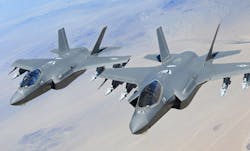Proposed 2022 DOD budget would increase defense spending to $715 billion -- $9.6 billion over this year
WASHINGTON – The administration of U.S. President Joseph Biden is asking Congress for $715 billion for the U.S. Department of Defense (DOD) in federal fiscal year 2022, which would be a modest increase of $9.6 billion over the 2021 request of $705.4 billion in the last year of the Trump Administration.
This increase would be an increase of 1.36 percent over last year's request. Of the 2021 request, submitted in February 2020, Congress enacted $703.7 billion. Federal fiscal year 2022 begins next 1 Oct.
In a nod to military technology development, The 2022 DOD budget request proposes spending $112 billion for defense research, development, test, and evaluation -- a 5.1 percent increase over 2021 -- which Biden Administration officials say would be the largest-ever Pentagon research budget.
Much of the military research budget would go for technological priorities like microelectronics, hypersonic missiles, artificial intelligence (AI), cyberspace capabilities, and a military 5G network, DOD officials say.
Related: Defense budgets likely to remain healthy during new Biden Administration
The 2022 DOD budget request includes $20.4 billion for missile defense, which represents a slight reduction over the $20.9 billion enacted in 2021.
The DOD budget request also has $6.6 billion for long-range fire support; $52.4 billion for fourth- and fifth-generation fighter aircraft; $34.6 billion for a hybrid fleet of manned and unmanned naval vessels; $12.3 billion for ground weapons and next-generation combat vehicles; $20.4 billion for cyberspace activities; and $122.1 billion for training, installation support, and support to U.S. allies.
The Biden Administration is asking Congress to authorize the purchase of 85 Lockheed Martin F-35 joint strike fighter aircraft next year for $12 billion, which would be a reduction from the $12.9 billion enacted in 2021 for 96 F-35 military planes.
The budget proposes spending $6.9 billion for two new Virginia-class (SSN 774) fast-attack submarines in 2022, which would be a slight decrease from 2021's $7.2 billion. It also would spend $5 billion next year for developing the future Columbia-class ballistic missile submarine, which is down from 2021's $4.5 billion.
Pentagon leaders also want to spend $3 billion next year developing the future B-21 Raider strategic heavy bomber aircraft, which is up from $4.5 billion in 2121. Likewise, military officials next year want to spend $2.9 billion developing the future Ford-class aircraft carriers, which is equal to 2021.
The proposed budget would spend $2.6 billion to continue the Next-Generation Overhead Persistent Infrared (NG OPIR) strategic missile warning system to blend mature resiliency features to increase survivability in a contested environment. Additionally, the U.S. Space Force would carry out a technology refresh of the sensor NG OPIR sensor to assure missile warning capabilities equal to or greater than today’s SBIRS.
In other major projects, the 2021 DOD budget proposal would spend $2.5 billion on the KC-46 aerial tanker; $2.4 billion to buy one new Arleigh Burke-class Navy destroyer; $1.8 billion on Global Positioning System (GPS) improvements; $1.7 billion on National Security Space Launch capability; and $1.7 billion to develop the CH-53K King Stallion heavy-lift helicopter.

John Keller | Editor-in-Chief
John Keller is the Editor-in-Chief, Military & Aerospace Electronics Magazine--provides extensive coverage and analysis of enabling electronics and optoelectronic technologies in military, space and commercial aviation applications. John has been a member of the Military & Aerospace Electronics staff since 1989 and chief editor since 1995.

